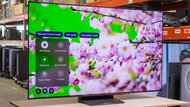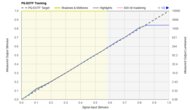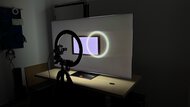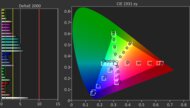Not too long ago, TVs in the 70- to 77-inch range were very expensive; however, that has changed in the past few years. However, there are not many 70-inch models available if you're looking for that exact size, and the TVs that are available in that specific size tend to be cheap models with mediocre picture quality, so you're very limited if you're looking for the best 70-inch TV. It's much easier to find the best 75-inch TV, as that's the most common size for LED models, while OLEDs are always released in 77-inch models instead.
Finding the right TV for your needs depends on your budget and usage. Although it's challenging to find the perfect TV, you likely want one that's bright enough to use in a room with your lights on and has good enough black levels to look good in a dark room. If you're looking for a TV to use in your home theater, you might also want certain features like Dolby Vision, HDR10+, and DTS audio passthrough so you don't run into compatibility issues. If you're a gamer with a modern console or PC, you likely want modern gaming features like HDMI 2.1 bandwidth, 4k @ 120Hz, and VRR. By meticulously testing dozens of TVs each year, we're able to determine what TVs fit these criteria. If you're unsure of what size TV to get, check out our TV Size to Distance Calculator to help decide.
Below are our recommendations for the best 70-75-77 inch TVs to buy. You can check out our picks for the best TVs, the best 65-inch TVs if you need something smaller, or the best 80-83-85-inch TVs if you want something bigger. Or, you can vote on which ones you want us to buy and test. To learn more about the TVs released in 2025, check out our 2025 TV lineup page.
Quick Look






We buy and test dozens of TVs yearly, taking an objective, data-driven approach to deliver results you can trust. Our testing process is complex, with hundreds of individual tests that take over a week to complete. Most of our tests are done with specially designed test patterns that mimic real content, but we also use the same sources you have at home to ensure our results match the real-world experience. We use two main tools for our testing: a Colorimetry Research CR-100 colorimeter and a CR-250 spectroradiometer.
-
Best 77-Inch TV
 Mixed Usage8.9Home Theater9.0Bright Room8.8Sports8.8Gaming9.3Brightness8.7Black Level10Color9.1Processing (In Development)8.3Game Mode Responsiveness9.4Resolution4kNative Refresh Rate165HzScreen FinishMatteTypeOLEDSub-TypeQD-OLEDSee all our test resultsDolby VisionNo
Mixed Usage8.9Home Theater9.0Bright Room8.8Sports8.8Gaming9.3Brightness8.7Black Level10Color9.1Processing (In Development)8.3Game Mode Responsiveness9.4Resolution4kNative Refresh Rate165HzScreen FinishMatteTypeOLEDSub-TypeQD-OLEDSee all our test resultsDolby VisionNoTopping our list is the QN77S95FAFXZA, which is currently the best 77-inch TV overall. This QD-OLED TV delivers an impressive combination of top-tier image quality, advanced gaming features, and all-around versatility. It produces exceptionally vivid colors that are rich, accurate, and bright, so the image is very punchy. With its ability to display inky blacks alongside bright highlights, HDR content looks amazing, especially in dark environments like home theaters. Unlike many OLED displays that struggle with reflections in well-lit spaces, this model handles them with ease thanks to its matte screen coating and strong SDR brightness. It's also a great option for larger rooms with wide seating arrangements, as the picture remains consistent even when viewed from the sides of the screen. The TV features Samsung's external Slim One Connect Box, providing a versatile way to manage your cables.
Gaming on this TV is very impressive for console and PC gamers alike. Its four HDMI 2.1 ports support 4k @ 165Hz, and it provides support for all three types of VRR, ensuring smooth, nearly tear-free gameplay across platforms. Motion clarity is outstanding thanks to its nearly instantaneous pixel transitions that OLEDs are known for. While it doesn't support Dolby Vision, the TV's brightness and support for HDR10+ still deliver a fantastic HDR experience.
-
Best Upper Mid-Range 77-Inch TV
 Mixed Usage8.6Home Theater8.8Bright Room7.6Sports8.1Gaming9.1Brightness8.0Black Level10Color8.8Processing (In Development)8.4Game Mode Responsiveness9.4Resolution4kNative Refresh Rate144HzScreen FinishGlossyTypeOLEDSub-TypeQD-OLEDSee all our test resultsDolby VisionNo
Mixed Usage8.6Home Theater8.8Bright Room7.6Sports8.1Gaming9.1Brightness8.0Black Level10Color8.8Processing (In Development)8.4Game Mode Responsiveness9.4Resolution4kNative Refresh Rate144HzScreen FinishGlossyTypeOLEDSub-TypeQD-OLEDSee all our test resultsDolby VisionNoIf you don't want a matte screen coating, the Slim One Connect Box, or 165Hz, you can save some money and step down to the Samsung QN65S90FAFXZA. This model features a traditional glossy screen finish and doesn't reach the same brightness levels in SDR, so it isn't quite as effective at handling reflections in well-lit rooms. However, its reflection handling is still great, and the TV is bright enough in SDR for use in moderately lit spaces without distracting reflections on your screen. In HDR, the TV delivers great brightness, allowing highlights to stand out well. Combined with its vivid colors and perfect black levels, you get excellent image quality in dark environments, making it a strong option for home theaters. It also features the same wide viewing angle as the Samsung S95F OLED, which is ideal for large living rooms with seating arrangements that are off-center.
While it doesn't include Samsung's Slim One Connect Box, the TV is still equipped with four HDMI 2.1 ports that support 4k @ 144Hz with VRR. It also has the same nearly instantaneous pixel transitions that are typical of OLED panels, ensuring that motion in fast-paced games is crisp and clear. Like the S95F and other Samsung models, it lacks Dolby Vision support. However, it does include the similar HDR10+, which still offers a high-quality HDR experience. Just be aware that you might not get a QD-OLED panel depending on your region.
-
Best Mid-Range 75-Inch TV
 Mixed Usage8.4Home Theater8.6Bright Room8.4Sports8.3Gaming8.4Brightness9.1Black Level9.2Color8.0Processing (In Development)7.8Game Mode Responsiveness8.0Resolution4kNative Refresh Rate144HzScreen FinishGlossyTypeLEDSub-TypeVASee all our test resultsDolby VisionYes
Mixed Usage8.4Home Theater8.6Bright Room8.4Sports8.3Gaming8.4Brightness9.1Black Level9.2Color8.0Processing (In Development)7.8Game Mode Responsiveness8.0Resolution4kNative Refresh Rate144HzScreen FinishGlossyTypeLEDSub-TypeVASee all our test resultsDolby VisionYesThe best 75-inch TV in the mid-range price bracket is the TCL 75QM8K, which is also one of the best Mini LED TVs available. While it doesn't match the perfect blacks of OLEDs, it gets surprisingly close due to its stellar local dimming, delivering deep, bold blacks with minimal haloing around subtitles and highlights. This TV stands out as one of the brightest on the market and offers solid reflection handling, making it great for very bright rooms. Combined with its wide range of bright and punchy colors, it's a versatile option that looks great in any setting.
Unlike the Samsung models, the TCL QM8K has only two HDMI 2.1 ports, which may limit those with multiple gaming devices. However, these two ports support 4k @ 144Hz, 1080p @ 288Hz, and VRR, so you can take full advantage of your console or push your PC to its limits. Additionally, the TV supports both Dolby Vision and HDR10+, ensuring you're covered regardless of the HDR format your content uses. The viewing angle is decent for setups where the seating is slightly angled from the screen, but image quality degrades at more extreme angles, which can make it less ideal for very large rooms.
-
Best Lower Mid-Range 75-Inch TV
 Mixed Usage7.8Home Theater7.9Bright Room8.0Sports7.9Gaming7.8Brightness7.8Black Level8.4Color7.5Processing (In Development)7.7Game Mode Responsiveness8.0Resolution4kNative Refresh Rate144HzScreen FinishGlossyTypeLEDSub-TypeVASee all our test resultsDolby VisionYes
Mixed Usage7.8Home Theater7.9Bright Room8.0Sports7.9Gaming7.8Brightness7.8Black Level8.4Color7.5Processing (In Development)7.7Game Mode Responsiveness8.0Resolution4kNative Refresh Rate144HzScreen FinishGlossyTypeLEDSub-TypeVASee all our test resultsDolby VisionYesIf the TCL QM8K sounds like the perfect TV for you, but it's out of your price range, you can go with the cheaper TCL 75QM7K and still get a great TV overall. While it's a bit dimmer than TCL's higher-end model, it's still bright enough to handle glare in well-lit rooms. Black levels aren't quite as good, but blacks still look bold and impressive, especially in darker environments, though there's a bit more haloing around highlights and subtitles. The TV isn't as bright as the QM8K in HDR, but it still delivers bright highlights that stand out well enough for an impactful HDR experience, especially when paired with its vibrant colors. Its viewing angle is relatively narrow, so it's best to sit directly in front of the screen for the best experience.
Beyond its solid image quality, this model offers a range of modern gaming features. With two HDMI 2.1 ports, support for 4k @ 144Hz, 1080p @ 288Hz, and VRR, it's a great choice for both console and PC gamers. It also supports both HDR10+ and Dolby Vision, so you're set no matter the content you're watching. If you're looking for an option that delivers solid performance and a wealth of features without breaking the bank, the QM7K is a fantastic choice.
-
Best Budget 75-Inch TV
 Mixed Usage7.1Home Theater7.2Bright Room7.0Sports7.1Gaming7.2Brightness6.5Black Level7.6Color7.2Processing (In Development)7.0Game Mode Responsiveness7.9Resolution4kNative Refresh Rate144HzScreen FinishGlossyTypeLEDSub-TypeVASee all our test resultsDolby VisionYes
Mixed Usage7.1Home Theater7.2Bright Room7.0Sports7.1Gaming7.2Brightness6.5Black Level7.6Color7.2Processing (In Development)7.0Game Mode Responsiveness7.9Resolution4kNative Refresh Rate144HzScreen FinishGlossyTypeLEDSub-TypeVASee all our test resultsDolby VisionYesIf you like the features of the TCL QM7K but need something more budget-friendly, the TCL 75QM6K is the best budget 75-inch TV. While it doesn't quite match the image quality of the higher-end models, it still delivers an impressive picture overall. Colors are slightly muted compared to those on the more expensive TCL models, but they remain vibrant enough to avoid appearing washed out. Blacks aren't as bold, but since the TV has a solid local dimming solution, blacks are still deep enough to give solid depth to the image, especially for a budget-friendly option. It gets bright enough in SDR to handle glare in well-lit rooms. However, its lower HDR brightness means highlights don't stand out as much as they should in HDR content. That said, it still provides a decent HDR experience overall.
It has the same core features found in its more expensive counterparts, including two HDMI 2.1 ports, support for 4k @ 144Hz, 1080p @ 288Hz, VRR, Dolby Vision, and HDR10+. As with other TCL models, the viewing angle is on the narrow side, so sitting directly in front of the screen will give you the best image quality. While the image quality might not be on the same level as the QM7K and the TCL QM8K, the features are nearly identical, which is very impressive for a TV this affordable.
Notable Mentions
-
LG OLED77G5WUA:
The LG G5 OLED is one of the best OLEDs on the market and competes with the Samsung S95F OLED. Unfortunately, the LG has some issues in some darker scenes that will bother enthusiasts. Since the Samsung is less quirky, a bit more colorful, and performs better in bright rooms, it's the better option for most people.
See our review -
LG OLED77C5PUA:
The LG C5 OLED is an alternative to the Samsung S90F OLED. The LG performs better in bright rooms, but the Samsung is brighter in its gaming mode and displays more vivid colors with less banding, making it the better option overall.
See our review -
LG OLED77B5PUA:
If you prefer the exceptional motion clarity and wide viewing angle of an OLED over a Mini LED model like the TCL QM8K, the LG B5 OLED offers those benefits at a similar price. However, the TCL outshines it with its significantly brighter panel, comparable black levels, and more well-rounded feature set, making it the better choice for most people.
See our review -
Hisense 75U75QG:
The Hisense U75QG is similar to the TCL QM7K, but it offers better peak brightness. Unfortunately, the Hisense makes HDR content look much brighter than intended and has more apparent motion blur due to its slower pixel transitions. Since the TCL offers clearer motion, has superior contrast, and offers 1080p @ 288Hz, it's the better TV overall.
See our review -
Hisense 75U65QF:
The Hisense U65QF is a brighter alternative to the TCL QM6K. Unfortunately, the Hisense really overbrightens HDR content, so it doesn't stay true to the content creator's intent. The TCL offers the more complete package, with better black levels, superior accuracy, 1080p @ 288Hz, and lower input lag.
See our review
Recent Updates
Nov 13, 2025:
Confirmed the accuracy of our picks, tweaked some text for clarity, and added a Quick Look section near the top of the article.
Aug 21, 2025:
Replaced the LG G4 OLED with the Samsung S95F OLED, the LG C4 OLED with the Samsung S90F OLED, the LG B4 OLED with the TCL QM8K, the TCL QM751G with the TCL QM7K, and the Hisense U6N with the TCL QM6K. We also refreshed the Notable Mentions, and dropped the 'Best Bright Room' category since multiple TVs on our current list outperform our old pick, the Sony BRAVIA 9.
Apr 15, 2025:
We replaced the Samsung S90D OLED with the LG G4 OLED as our top pick due to widespread power supply issues on the 77-inch S90D. We also added the Sony A95L OLED as an alternative to the G4 in the Notable Mentions section since the TVs are so evenly matched.
Jan 29, 2025:
Added a link to our 2025 TV Lineup page, updated some text for clarity, and confirmed the accuracy of our current picks.
Dec 05, 2024:
Rewrote the introduction for clarity and ensured the accuracy of our current picks.
All Reviews
Our recommendations above are what we think are currently the best 70-75-77 inch 4k TVs to buy for most people in each price range. You won't find the best 70-inch TV on our list since 70-inch models are more or less obsolete. We factor in the price (a cheaper TV wins over a pricier one if the difference isn't really worth it), feedback from our visitors, and availability (no TVs that are difficult to find or almost out of stock everywhere).
If you would like to do the work of choosing yourself, here is the list of all our reviews of 70-75-77 inch TVs. Be careful not to get too caught up in the details. While no TV is perfect, most TVs are great enough to please almost everyone, and the differences are often not noticeable unless you really look for them. Also, keep in mind that our scores aren't comparable across different test benches, so the older TVs in the list below score higher than they would today.















